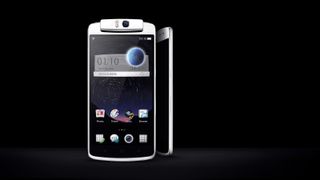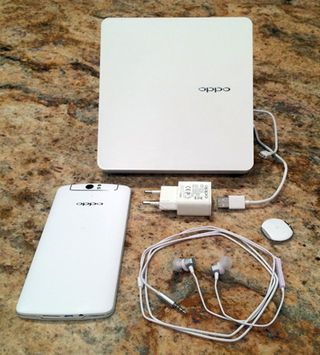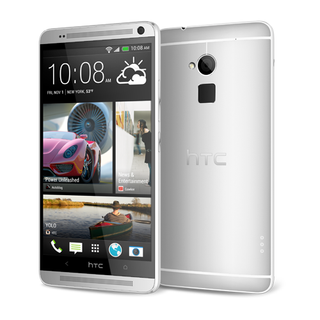Early Verdict
The Oppo N1 is a unique phablet chock full of hit-or-miss gimmicks. Overall, the lack of LTE, extra heft, previous-gen SoC, and relatively high price tag make this handset a questionable purchase.
Pros
- +
Industrial Design, Build Quality, OS Choice, O-Click, Battery Life
Cons
- -
No LTE, O-Touch, Performance, Poor Speaker Placement, Lackluster Audio Quality, Size
Why you can trust Tom's Hardware
Oppo Dreams Big: The N1 Phablet

Nearly seven years ago, the touchscreen-based smartphone passed from imagination to perceived phenomenon thanks to Apple's iPhone. Since then, we’ve witnessed the technology evolve continuously, the proliferation of cloud computing, the birth of two new platforms (Google’s Android and Microsoft’s Windows Phone), the rise and fall of several entrenched companies, and a fierce, yet farcical war over intellectual property. Meanwhile, amongst this chaos, the concept of the smartphone has coalesced into something ubiquitous.
Today, according to the IDC, around 80% of all smartphones run Android OS, while data from Strategy Analytics show Qualcomm dominating the SoC market with a 54% share by revenue, and a staggering 86% market share in LTE modems. With the OS and silicon variables largely replaced by those constants in the smartphone formula, OEMs, desperate to differentiate, continue tuning their own software packages, cameras, and form factors. The Oppo N1, a unique solution to this difficult equation, offers two OS choices (CyanogenMod, with access to the Google Play Store, and ColorOS, Oppo’s custom Android skin), plus a unique rotating camera and massive 5.9-inch screen. If those choices aren't extreme enough, Oppo also adds a rear touch panel and a remote control dongle.
The mad genius behind the N1 is a Chinese electronics company striving to make innovative, high-quality products. Founded in 2004, Oppo initially focused on the home theater space, but entered the mobile scene in 2008 after seeing an opportunity for exponential growth in the Asian phone market. Oppo received global recognition in 2012 when it announced the 6.65 mm-thick Finder. That was the world’s slimmest phone back then. The Find 5 arrived February, 2013, and was notable for being the first phone with a 1080p screen, as well as being Oppo’s first globally available device. This was soon followed by the R819, and then by today’s subject, the N1, which was the first phone to come preinstalled with CyanogenMod.

The N1 belongs to the phablet fraternity of phones: devices with a screen size larger than the average smartphone, but smaller than a tablet. It's a form factor precipitated from a saturated smartphone market steeped in OEM bravado and enabled by increases in SoC speed and RAM capacity. Its 5.9-inch, 1080p screen is currently among the largest available in a smartphone, and it is enclosed within an equally maximal chassis. With perimeter dimensions of 170.7 x 82.6 mm, it’s slightly larger than both the HTC One max and LG G Pro 2, and dwarfs Samsung’s largest offering, the Galaxy Note 3.
Packed inside the large chassis is a Qualcomm Snapdragon 600 quad-core SoC clocked at 1.7 GHz, 2 GB of LPDDR3 RAM, and either 16 GB or 32 GB of on-board NAND. Storage is not expandable however, since there’s no microSD slot (an unfortunate omission, as this has become somewhat of a standard phablet feature). Most of the N1’s volume is filled with a 3610 mAh, non-removable battery. While that’s 310 mAh more than the One max, and 410 mAh more than the G Pro 2 and Galaxy Note 3, the battery is removable in the latter two.
While the hardware inside the N1 is respectable and should achieve performance parity with the One max, it’s not typical of a flagship device released in Q4 2013. By then, Oppo’s opponents were shipping devices with the faster Snapdragon 800 SoC and more system memory. Clearly, the N1 won’t win any performance benchmarks, but there are still several interesting questions left to answer. Did Oppo include any performance optimizations in ColorOS, or will the leaner CyanogenMod prevail? Can the N1’s large battery feed its equally sizable screen all day long? Is the Snapdragon 600 still enough to power a phablet today?
Benchmarks alone won’t answer the most pressing question, however: is the N1 more than just a smartphone with a bigger screen? After all, it doesn’t make sense to sacrifice portability unless you gain functionality. With the Galaxy Note 3, for example, Samsung includes the S Pen and Multi Window multi-tasking to make better use of the larger form factor. Those are features that clearly target professionals and power users. Likewise, HTC includes premium, front-facing speakers, along with enhanced photo and video editing software, making the One max an entertainment powerhouse. Will the N1’s additional features come together in a worthy phablet, or does it become a big smartphone not worth lugging around?
Availability
Oppo started selling the N1 in December, 2013, but there are no carriers currently offering it on contract with a subsidized price. The only option is to purchase an unlocked phone from one of the retailers listed on Oppo’s website. You have a couple of different options to choose between: white with either 16 GB of internal NAND for $599 or 32 GB for $649. For those living in China, a dark blue, 16 GB model is also available.
The N1 supports quad-band GSM (850/900/1800/1900 MHz) and penta-band UMTS/WCDMA (850/900/1700/1900/2100 MHz), which gives it good global coverage, but limits carrier options in the U.S. Only AT&T and T-Mobile have compatible networks. Sorry, that means no Verizon or Sprint. Also notably absent is support for LTE, limiting bandwidth to either 3G or 4G (HSPA+) speeds.
Accessories

Accessories accompanying the N1 include a Europlug-style AC-to-USB charger (a North American charger is not supplied), USB-to-microUSB cable, earphones with silicone tips and an inline controller/mic, and documentation.
Current page: Oppo Dreams Big: The N1 Phablet
Next Page Look And Feel: Primarily Plastic, Positively Premium-
wavetrex Just a small comment about OLED, even if this might not be the place to write about it.Reply
Probably due to to imperfections in the transistors that control the OLED pixels, there is a very faint but perceptible in deep darkness leakage of energy toward the pixels.
Yes, doesn't compare to the obvious light bleed of any TFT display, but the OLED "off" pixels are not truly off, they have a 0.00something-small level of light which could theoretically be measured by some very sensitive equipment.
The eyes are certainly capable of seeing it... -
InvalidError Putting both flash LEDs on the same side so close to the image sensor seems like a missed opportunity to me: putting one LED close to each hinge with the camera in the middle would provide more even lighting and softer shadows.Reply
With the mostly passable image quality, that would not help the N1 much though. -
Onus Please don't put the letters "p" "h" "a" "b" "l" "e" "t" together in that order and treat it like a word.Reply
-
WyomingKnott @onusReply
First time I read the term I had the image of holding my 10" Asus pad up to my face and talking into it. I suppose it's better than a shoe; cleaner, too. -
shahbaz200 Bad GPU, doesn't works well on this device, poor performance, other than that its good device.Reply -
BlankInsanity please respect my opinion, but I don't see why phones need to go bigger. i the 90s phones used to be huge and this was a problem for mobility and so as the years went by they created smaller form factor phones. Now here we are repeating that mistake. A phone is ment to make a small footprint when hidden on it's user such as a pocket. You don't put your tablet in your pocket, I don't see why'd you make a phone out of it. this is just my opinionReply -
jankeke "please respect my opinion, but I don't see why phones need to go bigger. i the 90s phones used to be huge and this was a problem for mobility and so as the years went by they created smaller form factor phones. Now here we are repeating that mistake. A phone is ment to make a small footprint when hidden on it's user such as a pocket. You don't put your tablet in your pocket, I don't see why'd you make a phone out of it. this is just my opinion "Reply
True but people couldn't watch porn on their phones back then so it made sense to make them as small as possible. Not so now ... ^^ -
Matthew DiGiacomo No offense Tom's Hardware but why are you reviewing this phone now? It's outdated and been on the market for almost 8 months.. No one really cares about it anymore.Reply -
falchard The Camera is a smart solution meaning you won't need 2 cameras. Obviously it will need tilt support to tell it which direction is up.Reply
No removable battery is a shitty solution. Its the issue all phones face after 2 years, their batteries no longer hold a charge. -
BlankInsanity Reply13717317 said:The Camera is a smart solution meaning you won't need 2 cameras. Obviously it will need tilt support to tell it which direction is up.
No removable battery is a shitty solution. Its the issue all phones face after 2 years, their batteries no longer hold a charge.
lol that's a scam the companies do to force you to buy a new one ;)




